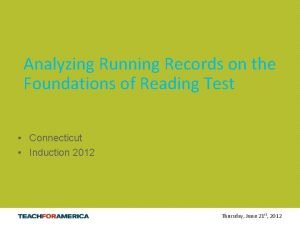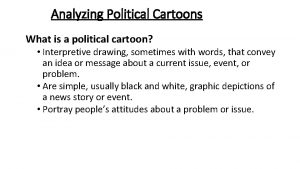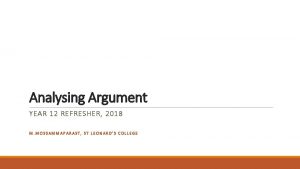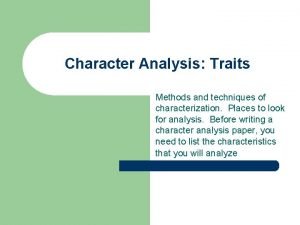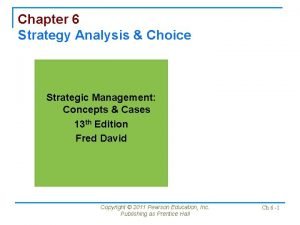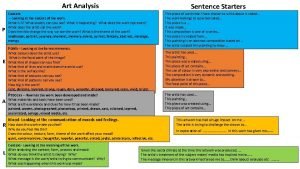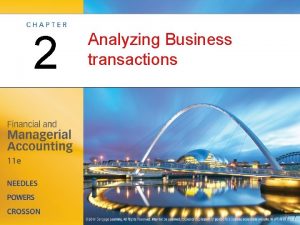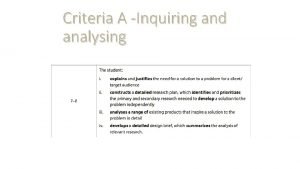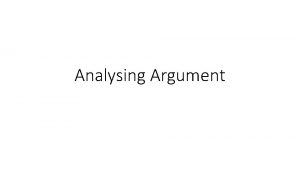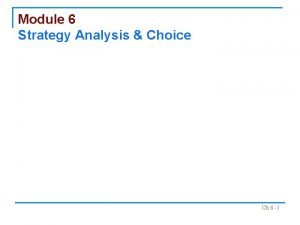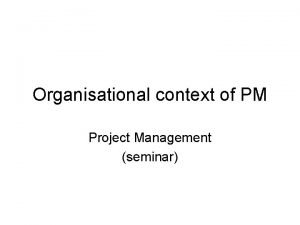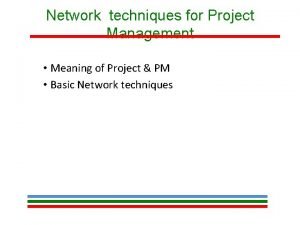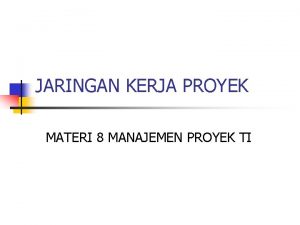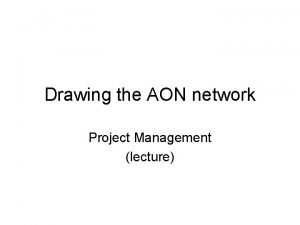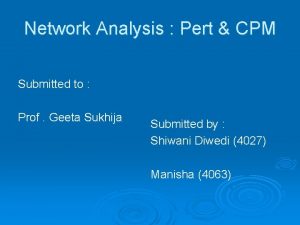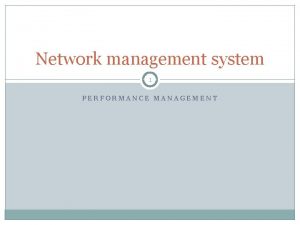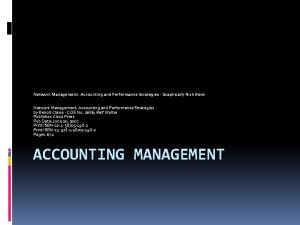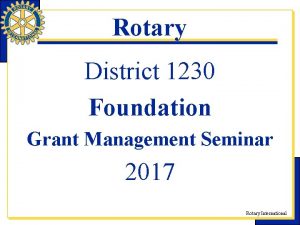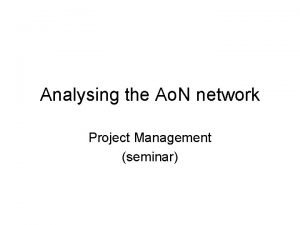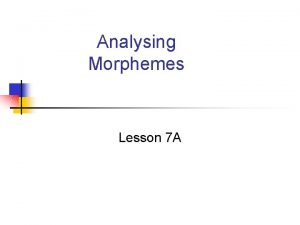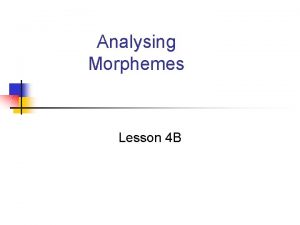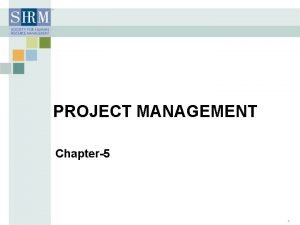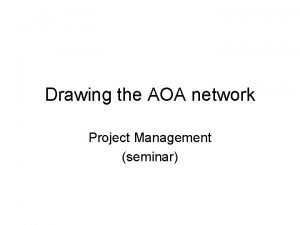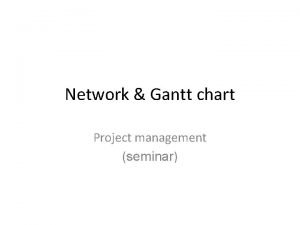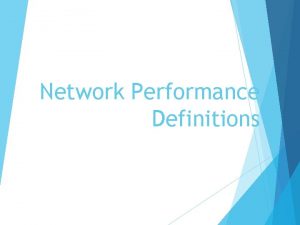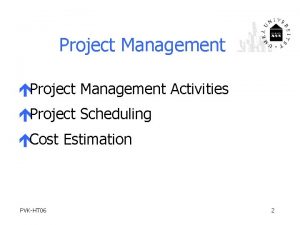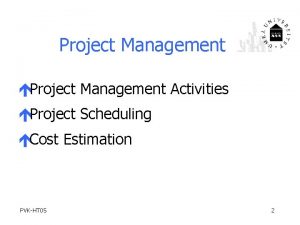Analysing the Ao A network Project Management seminar




















































- Slides: 52

Analysing the Ao. A network Project Management (seminar)

Total Project Time • The minimum time in which the project can be completed. • Calculation: forward pass Forward pass: calculating the earliest event times (EETs) and the earliest start times (ESTs) of all activities. Earliest Finishing Time = EST + Duration

Critical path • Path: continuous series of project activities connected by logical relationships as designated in the project schedule network diagram. • Critical path: sequence of activities that has no float time, and that determines the duration of the project. It is the longest path. Activities on the critical path are the critical activities. • The critical path can be identified by a backward pass, calculating the Latest Event Times (LETs) and the Latest Finishing Times (LFTs). • Latest Starting Time = Latest Finishing Time - Duration

Activity times & event times • EET = EST of all emerging activities • LET = LFT of all entering activities Deadline 1 EET Duration LET Activity identifier 2 EET LET

TPT EST 0 1 EFT 14 0 a LST 0 TPT = 14 2 LFT 14 14 14

Float • Float on activity ‘a’: 20 EST 0 1 EFT 14 0 14 6 a LST 6 Float: 6 2 LFT 20 14 20

4 22 8 ? d 6 5 24 10 ? e ? 34 Calculate the… • • EET of event 6 LETs of event 4 and 5 ESTs and EFTs of activity ‘d’ and ‘e’ LSTs and LFTs of activity ‘d’ and ‘e’

4 22 8 26 d 6 5 24 10 24 e • • 34 34 EST and EFT of ‘d’: 22 and 30 EST and EFT of ‘e’: 24 and 34 LST and LFT of ‘d’: 26 and 34 LST and LFT of ‘e’: 24 and 34

10 a 10 10 12 ? b 8 c 15 ? 20 ? 25 ? 30 35 25

10 a 10 10 12 17 b 8 c 15 20 20 22 25 18 30 35 25

Calculate all event and activity times and the float-times, find the critical path

Calculate all event and activity times and the float-times, find the critical path 16 16 24 24 8 29 20 0 0 21 30 31 0 20 20 20 35 35 35 36 35 38 38 50 39 39 51 51 51 30

Activity times and float for the previous diagram Activity A B C D E G H J K EST LST EFT LFT Float

Activity times and float for the previous diagram Activity EST LST EFT LFT Float A 0 8 16 24 8 B 0 0 20 20 0 C 0 21 30 51 21 D 20 20 35 35 0 E 20 29 30 39 9 G 35 36 38 39 1 H 35 35 51 51 0 J 16 24 31 39 8 K 38 39 50 51 1

Four characteristics of the critical path 1. 2. 3. 4. It starts at the first node It is continuous It ends at the last node It has no float

Floats in the Ao. A network

Activity and event times • Activity times: – EST – LST – EFT – LFT • Event times: – EET – LET

Float • Time available for an activity or path in addition to its duration. • It can be positive or negative • It is a property of activities (and available only at given activities) • In case of more succeeding activities, the minimum have to be taken. • Types of float: – Total float – Free float

Total float • The total float possessed by an activity. • Calculation for activity j: Total floatj = LFTj – EFTj • Identify the activity possessing float below, and calculate the total float. 12 1 2 ? ? 10 0 a c ? 15 8 b 3 ? ? d 4 ? 35

Total float • The total float possessed by an activity. • Calculation for activity j: Total floatj = LFTj – EFTj = LFTj – (ESTj + Dj) • Identify the activities possessing float below, and calculate the total float for each. Total float = = 11 – (0+5) = 6 5 1 2 5 11 Total float = 23 – (5+12) = 6 12 0 a c 0 15 8 b 3 15 15 d 4 23 23

Calculating free float • The float possessed by an activity which, if used, will not change the float in later activities. • Free floatj = ESTj+1 – EFTj = EEThead – EETtail - D Free float = =5– 0– 5=0 5 1 2 5 11 Free float = 23 – 5 – 12 = 6 12 0 a c 0 15 8 b 3 15 15 d 4 23 23

Negative float • If the target time (deadline) for the project (or for a part of the project) is grater than TPT, than the float will appear on the critical path or even on some other paths. • Negative float = the time by which activities on the path or paths concerned must be reduced if the TPT is to be met. 15 • Negative float is a type of the Total Float. 1 0 10 ? a 2 ? 10 ? c 3 ? ?

Negative float • If the target time (deadline) for the project (or for a part of the project) is grater than TPT, than the float will appear on the critical path or even on some other paths. • Negative float = the time by which activities on the path or paths concerned must be reduced if the TPT is to be met. 15 • Negative float is a type of the Total Float. 1 0 10 -5 a Total float: -5 2 10 10 5 c Total float: -5 3 20 15

Slack • Refers to events and not to activities. • Slack = LET - EET Slack: 6 Total float = = 11 – (0+5) = 6 5 1 2 Total float = 23 – (5+12) = 6 5 12 11 0 a c 0 15 8 b Slack: 0 3 4 23 23 d 15 Slack: 0

Readings • Lockyer – Gordon (2005) Chapter 13

Analysing the Ao. N network Project Management (seminar)

Data on the activity node EST Total Float EFT Activity label & description LST Duration LFT

Total Project Time • The shortest time in which the project can be completed. Determined by the critical path. • Calculation: forward pass Forward pass: The earliest start times (EST) of all activities are calculated. Trom these the earliest finishing times (EFT) are also calculated

Critical path • sequence of activities that has no float time, and that determines the duration of the project. It is the longest path. Activities on the critical path are the critical activities. • The critical path can be identified by a backward pass, calculating the Latest Finishing Times (LFT), and from these the Latest Starting Times (LST).

Floats in Ao. N • Total float: the time by which an activity can be delayed or extended without affecting the TPT. It can be used to delay the start of an activity or to increase its duration. TF = LST - EST • Free float: the time by which an activity can be delayed or extended without affecting the start of any succeding activity. FF = ESTj+1 - EFTj

Example: organising a conference • Objectives: to organise a 3 days long open scientific conference with 100 -200 participants, 30 -50 lectures, buffet reception, a conference book of the best studies and TV and radio interviews with some of the most known lecturers. • Create the WBS chart and create the task list with estimated durations and precedence relations (in a table form) • Plot both the Ao. A and Ao. N diagram • Calculate the TPT, identify the critical path the total and the free float times.

Example: WBS Project Event management Book Editing Publishing Collecting articles Peer reviewing Infrastructure Facilities Organising participants Staff Marketing Arranging event Materials Invitation and marketing Organising interviews

Task list with precedence relations Activity label Task description Duration (weeks) Immediate predecessors a Invitation 2 – b Organising participants 4 a c Facilities 3 b d Staffing 4 b e Materials 3 b hf Collecting articles 6 b gj Peer reviewing 3 f h k Publishing interviews Organising 5 1 c, d, e il Organising interviews Publishing 1 5 g Arranging event 1 h, i m j

Ao. A 4 19 9 3 c 1 0 0 2 a 2 2 2 4 b 3 6 4 d 6 5 19 10 3 e 6 19 10 6 5 i f 7 12 12 1 h 3 g 8 15 15 9 20 20 1 10 j 21 TPT = 21 CP: a-b-f-g-i-j 21

Ao. N 1 6 10 9 c 16 0 0 0 2 2 2 0 6 b 2 19 0 a 0 3 2 4 6 10 10 9 15 4 11 20 h d 6 0 9 1 19 19 10 20 20 9 0 e 16 3 15 6 0 12 0 15 12 f 6 6 0 20 12 3 5 20 15 g 12 0 i 19 0 15 21 j 1 6 0 TPT: 21 CP: a-b-f-g-i-j 1 21

Activity times for the previous diagram (finalize individually) Activity Duration EST LST EFT LFT Total float Free float a 2 0 2 0 0 b 4 2 6 0 0 c 3 6 9 16 19 10 1 d e f g h i j

Example 2 (for individual practice) a) Draw the Ao. A and Ao. N diagram with the data below: Activity label Duration (weeks) Immediate predecessors a 1 – b 2 a c 5 a d 3 a e 2 b f 2 e g 4 f, c, d b) Determine the TPT and the critical path and activity floats. c) Compute the EETs, LETs and slack for every node in the Ao. A & ESTs, LSTs, EFTs, LFTs in the Ao. N diagram.

Solution: Ao. A Float: 0 3 2 b Float: 0 3 5 2 e 3 1 0 Slack: 0 1 a Float: 0 2 1 5 c 1 2 f 5 Float: 0 Slack: 0 0 5 6 T. float: 1 F. float: 1 Slack: 0 7 7 Slack: 0 3 d T. float: 3 F. float: 3 4 4 4 g Float: 0 7 11 Slack: 0 0 7 Slack: 3 11 TPT: 11 CP: a-b-e-f-g

Solution: Ao. N 0 1 0 3 3 b 1 2 0 0 1 3 3 1 5 2 0 7 f 2 5 2 7 0 1 1 a 0 5 e 0 0 1 6 7 2 5 11 g c 1 0 7 7 4 11 3 4 d 4 3 7 TPT: 11 CP: a-b-e-f-g

Example 3 2 b 1 0 0 2 a 2 3 5 5 3 e 5 5 c 2 2 0 4 2 5 3 d 8 7 1 f 8 4 g 6 12 12 2 h a) Calculate the EETs and LETs. b) Create a precedence table (with task, duration, immediate predecessor, total and free floats). 14 14

Solution Activity Duration Total float Free float a 2 0 0 b 2 0 0 c 5 1 1 d 3 3 3 e 3 0 0 f 1 5 5 g 4 0 0 h 2 0 0

‘Crashing’ – reducing task durations by increased costs

Definition of crashing • Obtaining reduction in time at an increased cost (increasing the employed resources). • Cost-slope: the cost of reducing duration time by unit time. • Let’s see the following example: 0 6 0 0 0 4 a 0 4 0 6 b 4 4 2 1 1 8 8 c 7 2 1 10 0 e 9 9 2 11 11 0 14 f 0 6 6 0 11 d 6 5 11 11 3 14

Procedure for crashing 1. Crash one time unit at a time 2. Only the crashing of critical activities has any effect on TPT 3. Crash that activity first that is the cheapest to reduce in time 4. Be aware of multiple critical paths 5. Stop crashing when: • the crash-time is reached at every ‘crashable’ activity, • benefits of possible crashing are lower than crashing costs.

Crashing table • If the costs to reduce times are known, then a table can be set up showing the relative costs for the reduction in time of each activity by a constant amount. • Crash-time is the minimum duration of an activity. It is given by technical factors. Activity Duration Float Crash time Cost-slope (label) (day) a 4 0 2 100 b 2 0 2 150 c 2 1 1 110 d 5 0 3 e 2 1 1 f 3 0 2 200 Benefit of reducing TPT 160 by one day: 500 400 €/day (€/day)

Solution method 1. step: identify the critical activities 2. step: find the critical activity with cheapest crash cost, and if its cost slope is lower than the daily benefit from crashing, reduce its duration with one day. If there is no activity to crash, or it is too costly, stop crashing and go to step 4. 3. step: reidentify the critical path, and go back to step two. 4. step: identify the final critical path(s), TPT and the total net benefit of crashing.

Solution Path durations normal step 1 step 2 step 3 step 4 step 5 Path / activity crached crashed – a a d d, c none a-b-c-e-f 13 12 11 11 10 – a-b-d-f 14 13 12 11 10 – Cost: – 100 200 310 – Cumulated net benefit: – 300 600 890 – After crashing: – there are two critical paths – TPT is 10 days – total benefit of crashing is € 890

Example 2 (for individual work) 0 b d e 2 2 5 a 0 7 g 3 3 c f 3 3 • Identify the critical path and the TPT.

Example 2 (for individual work) 0 3 0 0 5 5 b 0 0 0 3 3 2 3 7 7 d 5 5 2 0 12 e 7 7 5 0 12 12 a 0 0 0 7 3 1 6 3 6 c 4 3 15 g 0 3 12 3 15 9 f 7 9 3 12 Critcal: a-b-d-e-g TPT: 15 Using tbe table on the next slide, calculate the optimal TPT with crashing.

Activity (label) Normal duration (day) Float (day) Crash time Costslope (€/day) a 3 0 1 500 b 2 0 1 550 c 2 1 1 150 d 5 0 3 900 e 5 0 4 400 f 3 3 2 100 g 3 0 3 200 • What is the new TPT? 10 days • What is the total profit on crashing? € 3000 Benefit of reducing TPT by one day: 1200 €/day

Reading • Lockyer – Gordon (2005) Chapter 8 pp. 61 -63. & Chapter 14

Thanks for the attention!
 Analyzing running records
Analyzing running records Exaggeration caricature analogy
Exaggeration caricature analogy Argument analysis structure
Argument analysis structure Analysing consumer market
Analysing consumer market Analysing a cartoon
Analysing a cartoon Methods of analysis character
Methods of analysis character Chapter 6 strategy analysis and choice
Chapter 6 strategy analysis and choice Analysis sentence starters
Analysis sentence starters How to analyse business transactions?
How to analyse business transactions? Inquiring and analysing
Inquiring and analysing Cultural aspects of strategy choice
Cultural aspects of strategy choice Analysing argument
Analysing argument Analysing the 6 strategic options megxit
Analysing the 6 strategic options megxit Analysing market data
Analysing market data Project management seminar
Project management seminar Traditional vs modern project management
Traditional vs modern project management Network 21 australia
Network 21 australia Network techniques in project management
Network techniques in project management Proyek jaringan komputer
Proyek jaringan komputer How to draw a project network
How to draw a project network Aon and aoa difference
Aon and aoa difference Advantages of pert
Advantages of pert Final year project presentation
Final year project presentation Project seminar presentation
Project seminar presentation The role of project management in achieving project success
The role of project management in achieving project success Modern project profiles in spm
Modern project profiles in spm Reducing project duration
Reducing project duration Modern project management began with what project
Modern project management began with what project What is strategic assessment in software project management
What is strategic assessment in software project management Perpetual project closure
Perpetual project closure Ms project agile planning
Ms project agile planning Varieties of project termination
Varieties of project termination Performance management in network management
Performance management in network management Network accounting management
Network accounting management Introduction to network management
Introduction to network management Accounting management in network management
Accounting management in network management Total quality management seminar
Total quality management seminar Performance management seminar
Performance management seminar Conflict management seminar
Conflict management seminar Rotary grant management seminar
Rotary grant management seminar Atlweather
Atlweather Hình ảnh bộ gõ cơ thể búng tay
Hình ảnh bộ gõ cơ thể búng tay Bổ thể
Bổ thể Tỉ lệ cơ thể trẻ em
Tỉ lệ cơ thể trẻ em Voi kéo gỗ như thế nào
Voi kéo gỗ như thế nào Tư thế worm breton
Tư thế worm breton Bài hát chúa yêu trần thế alleluia
Bài hát chúa yêu trần thế alleluia Các môn thể thao bắt đầu bằng từ đua
Các môn thể thao bắt đầu bằng từ đua Thế nào là hệ số cao nhất
Thế nào là hệ số cao nhất Các châu lục và đại dương trên thế giới
Các châu lục và đại dương trên thế giới Cong thức tính động năng
Cong thức tính động năng Trời xanh đây là của chúng ta thể thơ
Trời xanh đây là của chúng ta thể thơ
